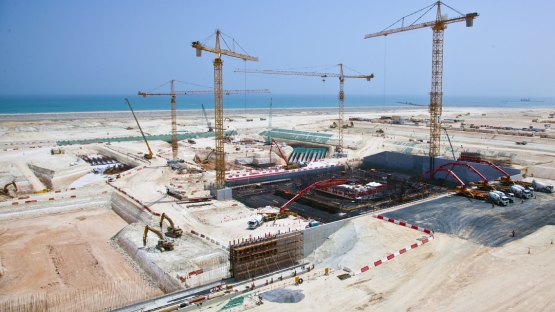Nuclear power’s global expansion is projected to continue in the coming decades—albeit at a slowing pace—amid challenges including low fossil fuel prices, a sluggish world economy and the legacy of Japan’s Fukushima Daiichi accident, according to an IAEA study released today.
Each year, the IAEA publishes projections of the world’s nuclear power generating capacity in Energy, Electricity and Nuclear Power Estimates for the Period up to 2050, now in its 35th edition.
“Several factors indicate that nuclear energy will play an important role in the world’s energy mix in the long run,” said IAEA Deputy Director General Mikhail Chudakov, Head of the Department of Nuclear Energy. “These factors include the volatility of fossil fuel prices, nuclear power’s role in greenhouse gas reduction, energy supply security, population growth and demand for electricity in the developing world.”
The latest projections point to slower growth in nuclear power, in keeping with the trend since the 2011 Fukushima Daiichi accident. The world’s nuclear power generating capacity is projected to expand by between 2.4% and 68% by 2030, compared with the previous estimate of between 7.7% and 88% from last year. Uncertainty related to energy policy, license renewals, shutdowns and future constructions accounts for the wide range.
The projections, developed by world experts who gather each spring at the IAEA, take into account developments through April 2015. The low case, designed to produce “conservative but plausible” estimates, assumes a continuation of current market, technology and resource trends with few changes to policies affecting nuclear power. The high case assumes current rates of economic and electricity demand growth, particularly in Asia, will continue while also including a bigger role for nuclear power in climate change mitigation strategies worldwide.
Factors Weighing on Growth
Over the short term, several factors are weighing on the growth prospects of nuclear power, leading to temporary delays in deployment of some plants, according to the report. These factors include low prices for natural gas, subsidized renewable energy sources, and the global financial crisis, which presents hurdles for capital-intensive projects. Heightened safety requirements as a result of stress tests introduced in the wake of the Fukushima accident and the deployment of advanced technologies have also contributed to delays.
The estimates also factor in the likely future retirement of many of the world’s 438 nuclear reactors currently in operation, more than half of which are over 30 years old. Despite the need to replace scores of retiring reactors, nuclear power is still set to maintain—and possibly increase—its role in the world’s low-carbon energy mix, according to David Shropshire, Head of the IAEA’s Planning and Economic Studies Section.
“In order to maintain such a role, each retiring reactor would need to be replaced,” Shropshire said.
“Our low-case projections show that for every unit of capacity retiring, another unit will be built somewhere in the world by 2030; and in the high case, about 1.7 times the capacity will be constructed.”
Regional Breakdown
Although not a major driving force, the policies and developments in the more than 30 countries that are considering or planning their first nuclear power plant also play a role in the projections. The IAEA recently updated one of its key guidance documents, Milestones in the Development of a National Infrastructure for Nuclear Power, which forms the basis for its assistance to these “newcomer” countries.
They include the United Arab Emirates, which is building its first reactors and contributing to projected growth in the Middle East and South Asia, where India is driving the expansion and constructing six new reactors. According to the 2015 projections, capacity growth in that region is projected at 25.9 GW(e) by 2030 in the low case from the current 6.9 GW(e), rising to 43.8 GW(e) in the high case. One gigawatt is equal to one billion watts of electrical power.
Growth is also projected in Eastern Europe. The region includes Russia, with nine reactors under construction, as well as Belarus, which is building its first reactors. The low case estimate projects regional capacity growth to 64.1 GW(e) by 2030 from the current 49.7 GW(e), with capacity increasing to 93.5(e) in the high case.
The Far East, meanwhile, will see the biggest expansion, especially in China and the Republic of Korea, which are building 24 and four reactors respectively. In the low case, capacity in that region is seen growing to 131.8 GW(e) by 2030 from the current 87.1 GW(e). In the high case, capacity is projected to expand to 219 GW(e).
By contrast, Western Europe is eyeing the biggest decline. With Germany, the region’s biggest economy, announcing plans to phase out nuclear power in the wake of the Fukushima accident, the low projections estimate a decrease in Western European capacity to 62.7 GW(e) by 2030 from the current 113.7 GW(e). The high projections estimate a decline to 112 GW(e).
North American capacity is also seen falling in the low case to 92 GW(e) by 2030 from the current 112.1 GW(e). The high projections, however, estimate an increase to 139.7 GW(e).
“It’s important to understand that these projections, while carefully derived, are not predictions,” said Andrii Gritsevskyi, Energy System Analyst in the IAEA’s Planning and Economic Studies Section. “The estimates should be viewed as very general growth trends, whose validity must be constantly subjected to critical review.”





